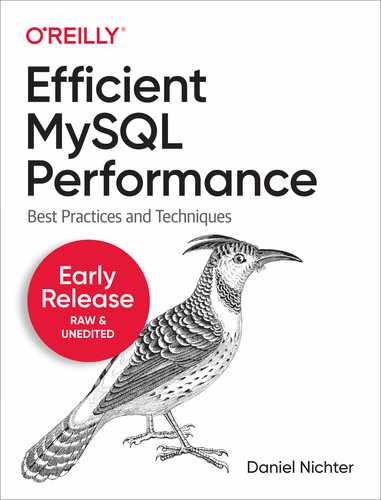You'll find several books on MySQL basics today, but only one that covers advanced MySQL performance--and nothing in between. That's because explaining MySQL performance without addressing its complexity is difficult. This practical book bridges the gap by teaching developers mid-level MySQL knowledge beyond the fundamentals, but well shy of deep-level internals required by DBAs. Daniel Nichter shows you how to apply best practices and techniques that directly affect efficient MySQL performance. You'll learn how to focus on query response time, optimize queries and data to increase performance, and monitor and understand the most important MySQL metrics. You'll also discover how not to use MySQL, including situations where this database is clearly the wrong choice.
Table of Contents
- Preface
- 1. Query Response Time
- A True Story of False Performance
- North Star
- Query Reporting
- Sources
- Aggregation
- Reporting
- Query Analysis
- Query Metrics
- Metadata and the Application
- Relative Values
- Average, Percentile, and Maximum
- Improving Query Response Time
- Direct Query Optimization
- Indirect Query Optimization
- When to Optimize Queries
- Performance Affects Customers
- Before and After Code Changes
- Once a Month
- MySQL: Go Faster
- Summary
- Practice: Identify Slow Queries
- 2. Indexes and Indexing
- Red Herrings of Performance
- Better, Faster Hardware!
- MySQL Tuning
- MySQL Indexes: A Visual Introduction
- InnoDB Tables Are Indexes
- Table Access Methods
- Leftmost Prefix Requirement
- EXPLAIN: Query Execution Plan
- WHERE
- GROUP BY
- ORDER BY
- Covering Index
- Join Tables
- Indexing: How to Think Like MySQL
- Know the Query
- Understand with EXPLAIN
- Optimize the Query
- Deploy and Verify
- It Was a Good Index Until…
- Queries Changed
- Too Many, Dupes, and Unused
- Extreme Selectivity
- It’s a Trap! (When MySQL Chooses Another Index)
- Table Join Algorithms
- Summary
- Practice: Find Duplicate Indexes
- 3. Data
- 4. Access Patterns
- MySQL Does Nothing
- Performance Destabilizes at the Limit
- Toyota and Ferrari
- Data Access Patterns
- Read-Write
- Throughput
- Data Age
- Data Model
- Transaction Isolation
- Read Consistency
- Concurrency
- Row Access
- Result Set
- Application Changes
- Audit the Code
- Offload Reads
- Enqueue Writes
- Partition Data
- Don’t Use MySQL
- Better, Faster Hardware?
- Summary
- Practice: Describe an Access Pattern
- 5. Sharding
- 6. Server Metrics
- Query Performance vs. Server Performance
- Normal and Stable: The Best Database Is a Boring Database
- Key Performance Indicators
- Field of Metrics
- Response Time
- Rate
- Utilization
- Wait
- Error
- Access Pattern
- Internal
- Spectra
- Query Response Time
- Errors
- Queries
- Threads and Connections
- Temporary Objects
- Prepared Statements
- Bad SELECT
- Network Throughput
- Replication
- Data Size
- InnoDB
- Monitoring and Alerting
- Resolution
- Wild Goose Chase (Thresholds)
- Alert on User Experience and Objective Limits
- Cause and Effect
- Summary
- Practice: Review Key Performance Indicators
- Practice: Review Alerts and Thresholds
- 7. Replication Lag
- Foundation
- Source to Replica
- Binary Log Events
- Replication Lag
- Causes
- Transaction Throughput
- Post-Failure Rebuild
- Network Issues
- Risk: Data Loss
- Asynchronous Replication
- Semi-synchronous Replication
- Reducing Lag: Multi-threaded Replica
- Monitoring
- Recovery Time
- Summary
- Practice: Monitor Sub-Second Lag
- 8. Transactions
- Row Locking
- Record and Next-key Locks
- Gap Locks
- Secondary Indexes
- Insert Intention Locks
- MVCC and the Undo Logs
- History List Length
- Common Problems
- Large Transactions (Transaction Size)
- Long-running Transactions
- Stalled Transactions
- Abandoned Transactions
- Reporting
- Active Transactions: Latest
- Active Transactions: Summary
- Active Transaction: History
- Committed Transactions: Summary
- Summary
- Practice: Alert on History List Length
- Practice: Examine Row Locks
- 9. Other Challenges
- Split-brain Is the Greatest Risk
- Data Drift Is Real but Invisible
- Don’t Trust an ORM
- Schemas Always Change
- MySQL Extends Standard SQL
- Noisy Neighbors
- Applications Do Not Fail Gracefully
- High Performance MySQL Is Difficult
- Practice: Identify the Guardrails that Prevent Split-brain
- Practice: Check for Data Drift
- Practice: Chaos
- 10. MySQL in the Cloud
- Index
